History
Here are some highlights from the history of the University.
In 1983, Halmstad University became an independent university, five years after the first courses had started. At that time, the University had 540 students and around 60 employees. Today, the University has roughly 12,000 students, 700 employees and offers around 50 educational programmes and 200 independent courses at various levels, for both national and international students. The University also the right to award doctorates in Innovation Science, Information Technology and Health and Lifestyle. It all started back in the 1970s when the N-committee was formed to prepare a future university in Halmstad.
2024
The first class of social workers graduates. The number of applicants increases significantly, with seven percent more first-choice applicants compared to the previous year. All research and co-production are evaluated in an evaluation called ARC24. All of the University’s research areas are of good quality, several areas show very good or even excellent quality. Particular emphasis is placed on the University’s collaboration with external parties and research in AI and health. The University decides on its seventh multidisciplinary research programme, Future Industry. The University becomes a European University through the HEROES collaboration, which includes nine universities in eight countries. A new service area is being established, Support for teaching and learning, with the aim of contributing to continued quality-enhancing efforts for students’ learning, the quality of education and teachers’ professional skills.
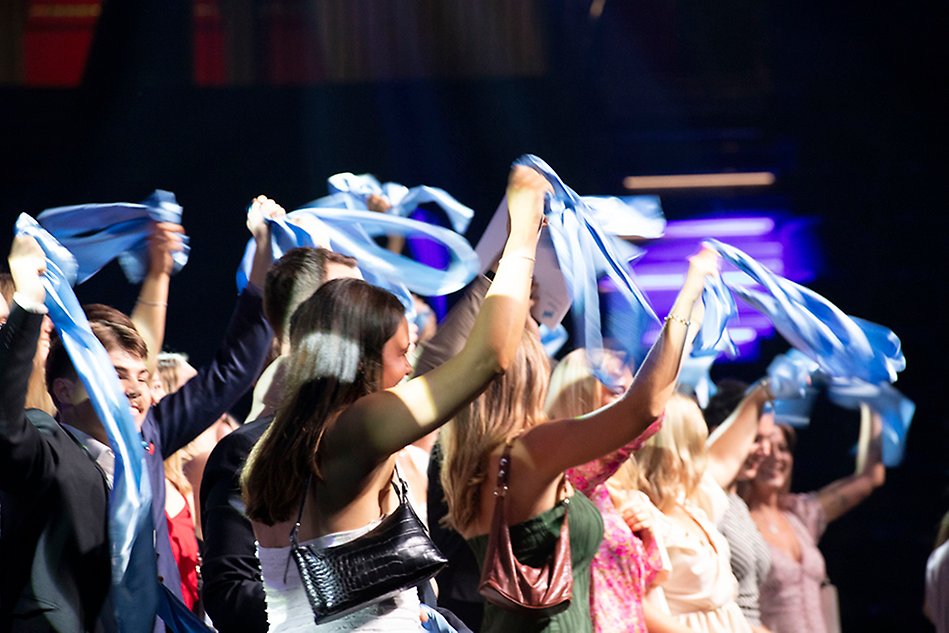
2024: The number of applicants per place to the University’s programmes is increasing significantly.
2023
The University celebrates 40 years as an independent institution with pride and festivity! The University’s first female Vice-Chancellor, Susanna Öhman, is inaugurated. The University hosts the international research conference Nordic Health Promotion Research Conference. Media and Communications mark 30 years with an alumni reunion, the Service Center turns ten years old, and the Pre-School Teacher Education celebrates 40 years. The King and Queen visit the University. Halmstad Municipality organises ’Guldmorgon’ on campus. A commemorative logo is created, along with a unique fanfare and an anniversary collection featuring sweaters and tote bags. Paulsson’s Bakery creates an anniversary cake for the University. Several of the Univeristy’s leaders and researchers write anniversary chronicles. Halmstad Student Union turns 40 and celebrates throughout the academic year 23/24
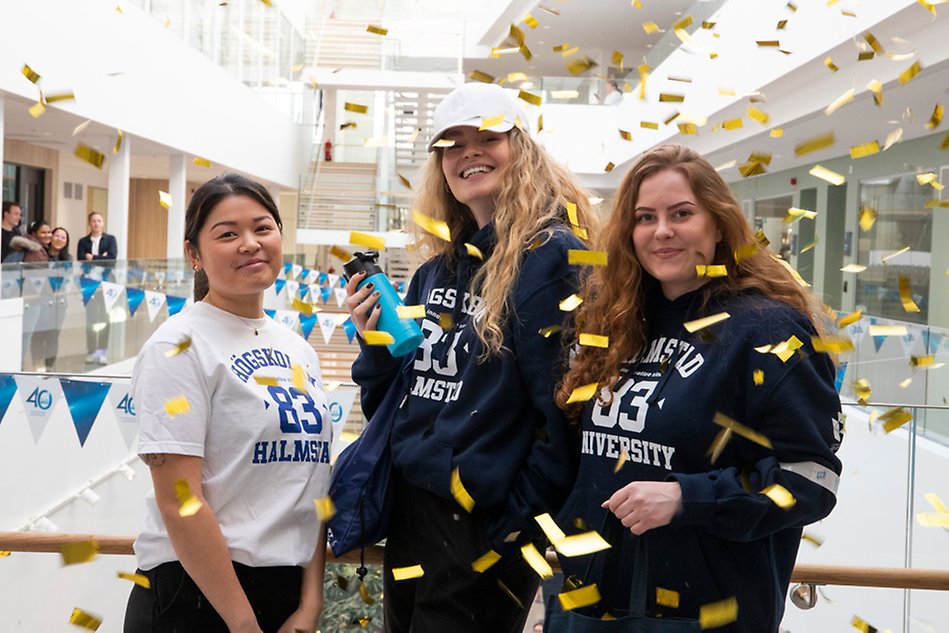
2023: The University celebrates 40 years as an independent institution.
2022
The start of the year is still in the pandemic, but soon both work and teaching return to normal. The lessons learned from the pandemic are taken into account, both through digital examinations and remote work. The Swedish Higher Education Authority's (UKÄ) approves the University's quality assurance system. The Utexpo student fair celebrates 40 years and moves to the bright premises in the S building. The new programme Applied artificial intelligence (AI) starts and the E-sport Lab is relaunched. The University establishes research programmes that will strengthen the institution's profile: the first two are LeaDS, Learning in a Digitalised Society, and IDC, Information Driven Care. Three new professors are inagurated as well as seven new doctors and one honorary doctor are conferred at the academic ceremony.
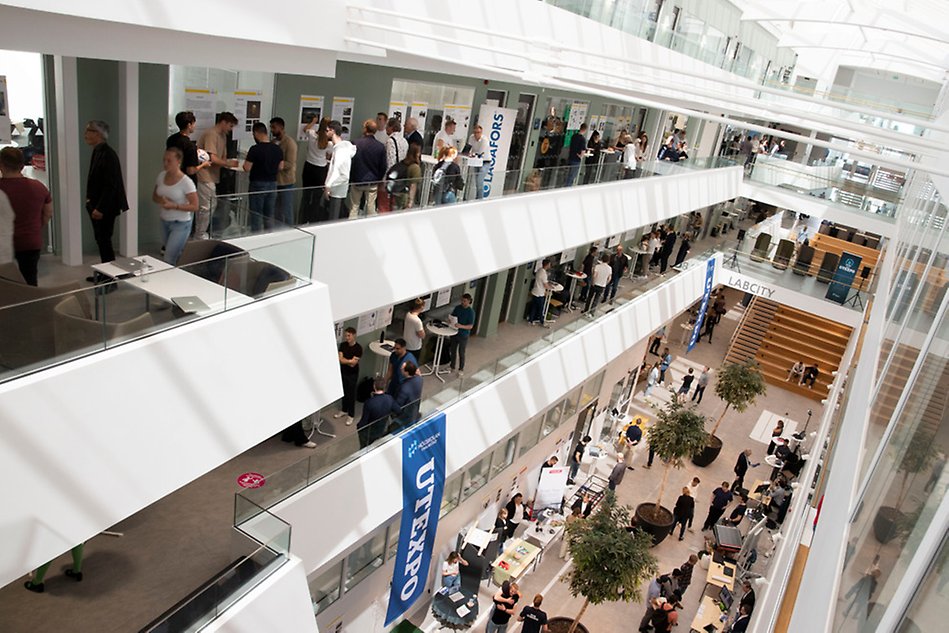
2022: Utexpo moves to the S building.
Utexpo 40 years: innovation and scholarships
University quality assurance system approved by the Swedish Higher Education Authority
Research programmes for profiling
2021
This year is also marked by the pandemic with many changes and adaptations. The business nevertheless continues to develop successfully. Thirteen new professors are inaugurated and ten prosperous years as a Competence and Knowledge Centre are summed up. A research strategy for the years up to 2030 is decided by the University Governing Board. Funds are granted for new graduate schools, including a national research school in health innovation that the University hosts. Hosting the international conference New Business Models puts the University on the world map. Once again, interest in the University's programmes and courses is at a record high. The research profile CAISR Health starts.
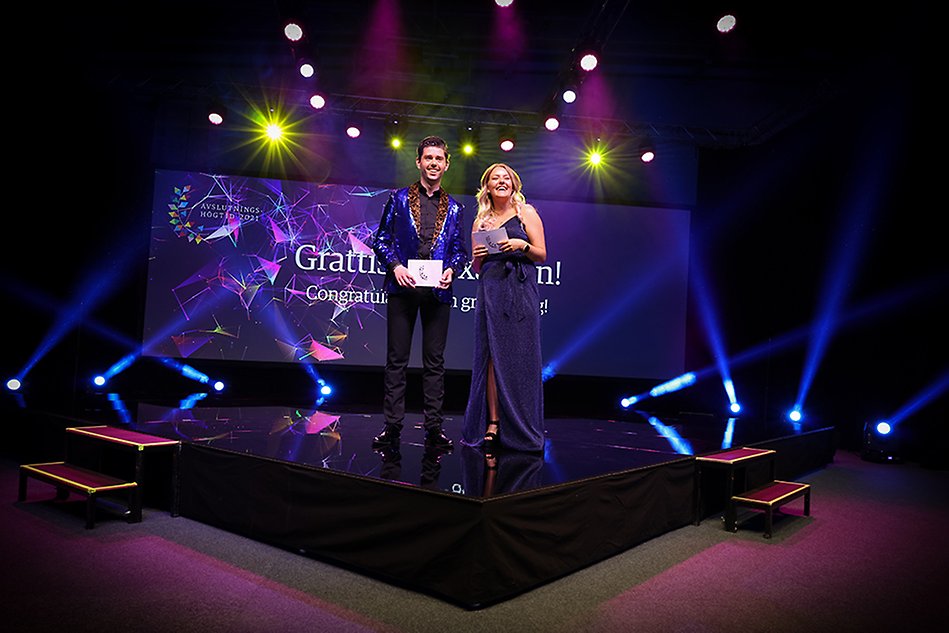
2021: Timmie Hansson and Elin Kjellsson held the programme together during the digital graduation ceremony. Photo: Ida Fridvall
2020
The year was characterised by the covid-19 pandemic and major changes appear. The University takes great social responsibility to ease the effects on the labour market through specially adapted courses for professionals and the ESF project Kompa Halland. Among the highlights during the year is the record breaking number of people applying to the University’s programmes and courses, 32 percent more than the year before. Two new education programmes are started: Social Work Programme and Master of Engineering in Mechanical Engineering, Sustainable Design and Innovation. A new regional innovation centre for information-driven care, Leap for Life, is established. A new honorary doctor in Innovation Sciences is appointed. The School of Business, Engineering and Science changed its name to the School of Business, Innovation and Sustainability and moved into completely renovated new S building.

2020: During the autumn the School of Business, Innovation and Sustainability moved into into the new S building which has been completely renovated with starting point in sustainability, indoor environment, collaboration and flexibility.
2019
Halmstad is appointed The Student City of the Year by the Swedish National Union of Students, SFS, thanks to the close cooperation between the University, the Student Union and Halmstad Municipality. Common Core is launched – a concept with compulsory common courses for all students – after several years of preparation. A new external website and a student website are launched. The University gains rights to award bachelor's degrees in Social Work. Several large research projects within health innovation and smart cities and communities receive funding – many focusing on artificial intelligence and collaboration with the business and public sectors. The University Board decides on targets for the institution and the coming ten-year period.
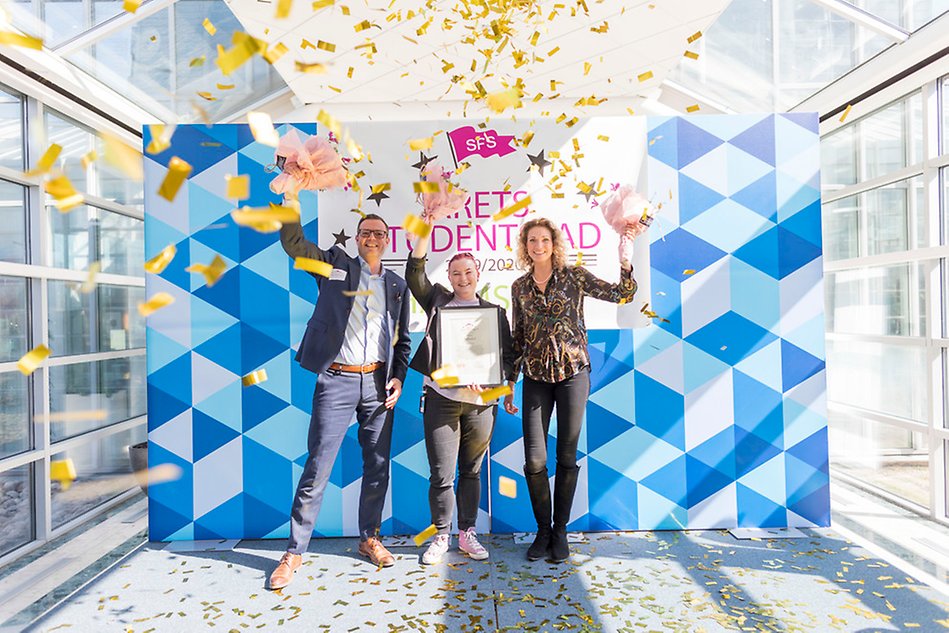
2019: Halmstad is appointed The Student City of the Year by the Swedish National Union of Students, SFS, thanks to the close cooperation between the University, the Student Union and Halmstad Municipality.
2018
The start of a new annual tradition – a new joint graduation ceremony for all students. Two new awards are established, Alumnus/Alumna of the Year and Student of the Year, and the University becomes a Swedish National Sports University. Two EU projects are granted funds: Digga Halland and Test Environment Halland. Pernilla Nilsson becomes new Pro Vice-Chancellor. Thorsteinn Rögnvaldsson becomes new Programme Manager for the Knowledge and Competence Centre Research for innovation. Anna Isaksson is appointed Programme Director for gender mainstreaming. The University’s two profile areas Health Innovation and Smart Cities and Communities got new Programme Managers: Jens Nygren and Magnus Jonsson respectively. Two new School Deans: Lena-Karin Erlandsson at the School of Health and Welfare, and Susanna Öhman at the School of Education, Humanities and Social Sciences.
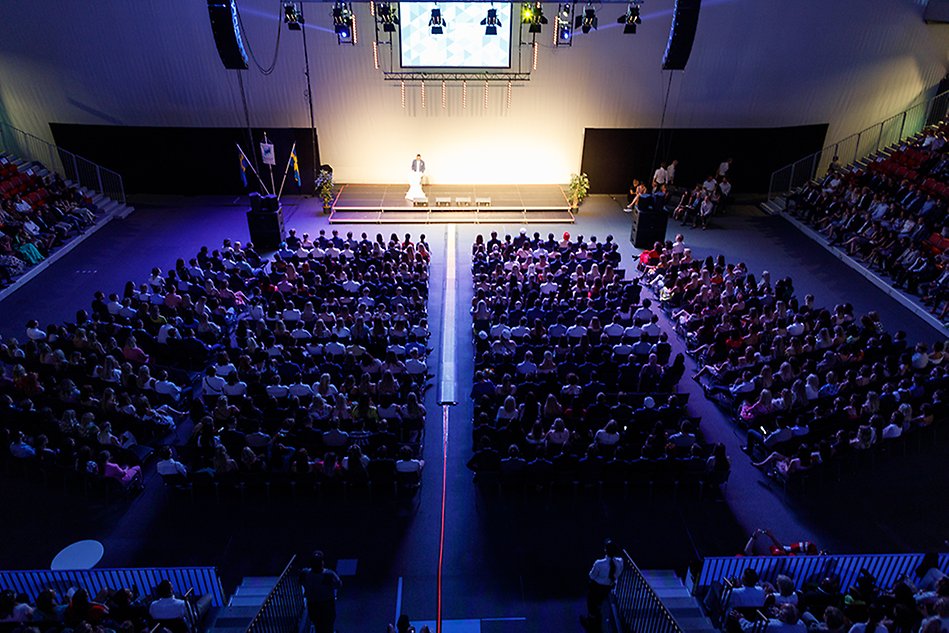
2018: the University celebrates its first joint graduation ceremony for all students. Photo: Anders Andersson
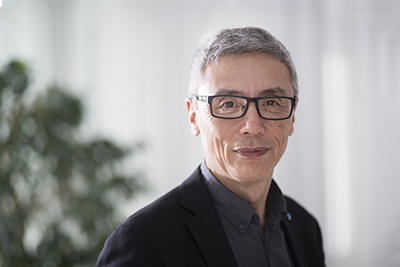
2017: Stephen Hwang becomes Vice-Chancellor.
2017
The collaboration arena and learning environment Health Lab is opened, the volume of research increases and applications from international students are almost doubled. The University continues to be a force in the development of the region, through (among other things) agreements with the municipality. Stephen Hwang is inaugurated as new Vice-Chancellor, Harald Castler takes over the presidency of the University Governing Board and Catarina Coquand becomes the new University Director. Anders Nelson becomes the first Deputy Vice-Chancellor with specific responsibility för collaboration, internationalisation and innovation. During the academic ceremony, three new professors are inaugurated and four new doctors are conferred. Hans-Erik Eldemark becomes the first person to receive the newly established Prize for Collaboration and Innovation.
2016
In September, Vice-Chancellor Mikael Alexandersson leaves his position after five years at Halmstad University. Pro Vice-Chancellor Thorsteinn Rögnvaldsson substitutes as Vice-Chancellor during the recruitment process. On November 18, the University celebrates its academic ceremony for the tenth time and seven professors are inaugurated. Both the Digital Laboratory Center (DLC) and Fab Lab are opened. The profile area Smart Cities and Communities is established.
2015
The Electronics Centre in Halmstad (ECH) is inaugurated. Several international collaborations in, among other places, China, Brazil, the United States and India, are started or strengthened. The University makes several major organisational changes: the five schools become four, the eight research environments become six and the administrative support is reviewed and reorganised. A new main entrance is built and Kafé Framkanten is opened.
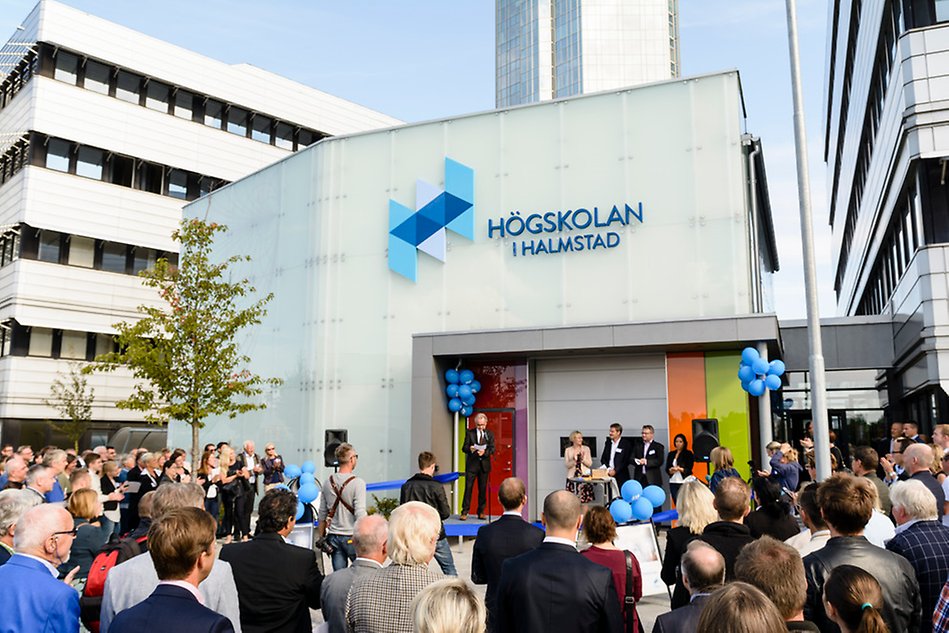
2015: Helene Hellmark Knutsson, Minister for Higher Education and Research, inaugurates the Electronics Center in Halmstad (ECH). Photo: Joachim Brink
2014
The number of educational programmes is heavily reduced while the level of research increases. Many educations are once again top ranked in societal collaboration. The theme Health Innovation, a University spanning venture, is launched, as well as a doctoral education in Health and Lifestyle. The Centre for Educational Development (HPC) is established at the University, as well as a Bennet professorship. The University's first education for Master of Science in Engineering also starts this year.
2013
The University receives the right to independently conduct doctoral education and award doctorates for Health and Lifestyle. The University is also granted the right to award degrees of Master of Science in Engineering. In the same year, the University institutes the Assessment of Research and Coproduction, ARC13, – an international evaluation of all the University’s research where the University gets good results. Thorsteinn Rögnvaldsson is appointed Pro Vice-Chancellor and Pernilla Nilsson is appointed Deputy Vice-Chancellor. The University also celebrates its 30th anniversary and launches a new vision, logotype and graphic charter. A new, collective Service Centre is opened and the graduate school EISIGS starts.
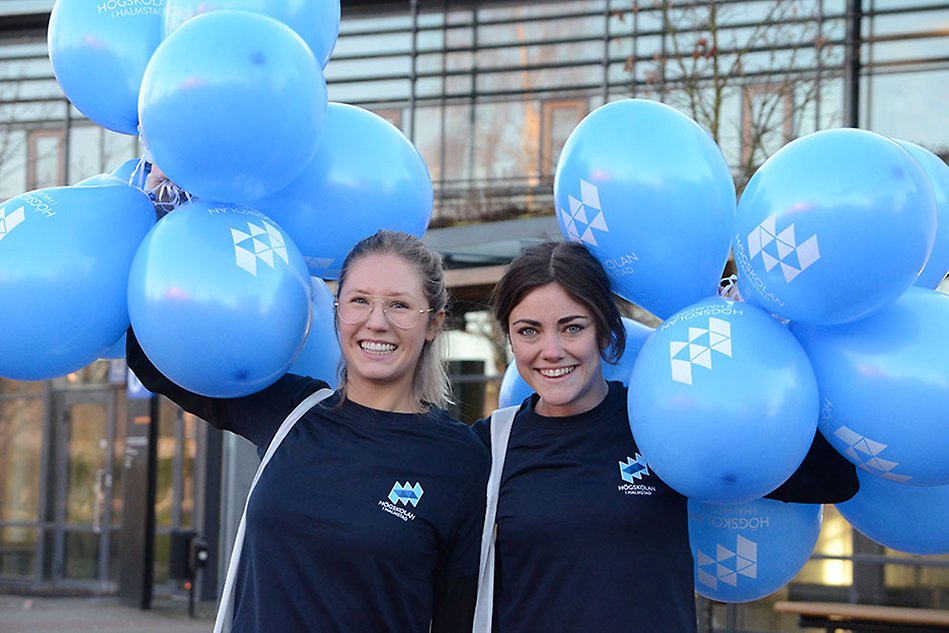
2013: The University celebrates its 30th anniversary and launches a new logo.
2012
This year marks the beginning of major change and profiling at the University. The focus is innovation and Innovation day is carried out and the book "Perspectives on Innovation" (svenska: Perspektiv på innovation") is published at the University. At the end of the year, the board of the Knowledge Foundation decides to grant the University SEK 70 million for research and co-production of innovation in the new Knowledge and Competence Centre. Center for Applied Intelligent Systems Research (CAISR) starts.
2011
The University welcomes its new Vice-Chancellor Mikael Alexandersson. This is also the year the University is designated a Knowledge and Competence Centre by the Knowledge Foundation, named Research for Innovation. The University's first own doctor, Edison Pignaton de Freitas, is awarded a doctoral degree in Information Technology. The University appoints its first honorary doctor, Jan Einar Blomquist, Honorary Doctor in Innovation Science.
2010
The University receives the right to conduct doctoral education and to award doctoral degrees in two areas: Information Technology and Innovation Sciences. Karin Starrin is appointed Chairman of the University Governing Board and Carina Ihlström Eriksson becomes Pro-Vice-Chancellor. It is no longer mandatory to join the Student Union.
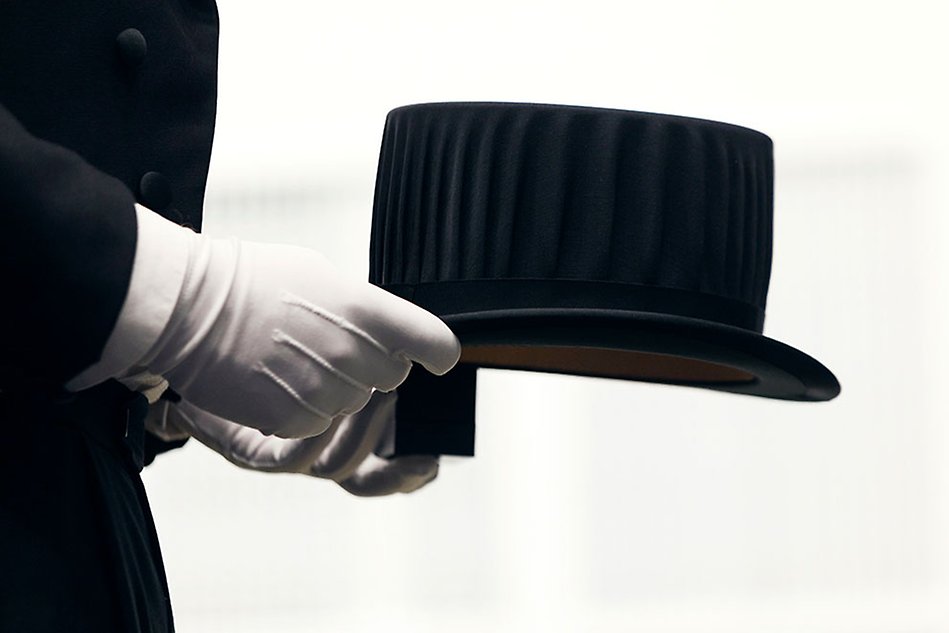
2010: The University receives the right to conduct doctoral education and to award doctoral degrees in Information Technology and Innovation Sciences.
2009
As the first small university, Halmstad University is given the right to award Master’s degrees in Business and Economics. This year also marks the beginning of the Health Technology Centre of Halland (Hälsoteknikcentrum Halland, HCH), supported by the European Regional Development Fund and Region Halland. Romulo Enmark is reappointed as Vice-Chancellor for a three-year period and six new Professors are appointed. A strategic milestone for the University is reached when the institution is accepted as a "candidate" to become a Knowledge and Competence Centre.
2008
The University is awarded the right to offer Master’s degrees in Health Science. Science Park Halmstad is inaugurated and a new graphic charter is launched. The University celebrates its 25th anniversary with a large summer party and now has around 40 Professors.
2007
The University's profiling in three areas of strength is gaining serious momentum. The University gains the right to award Master’s degrees in Computer Technology, Innovation, and Entrepreneurship. Six new Professors are inaugurated. The Teaching and Learning Prize is awarded for the first time, to Bertil Gustafsson, Lecturer in Pedagogy.
2006
The University starts to adapt the education acording to the Bologna process and the newly-built Health and Sports Centre is inaugurated. Marita Hilliges is appointed Pro Vice-Chancellor and four new Professors are appointed. A strategic agreement is concluded with Jönköping University and the University of Skövde on research collaboration in the humanities and social sciences. It is the first time the University arranges Sommaröppet on a day in July. All of 1,100 people apply for the 33 courses that are offered within the Summer University. The graduate school in Entrepreneurship – health starts.
2005
A strategic effort for education within "The Summer University" is made. The research profile CERES, Centre for Research on Embedded Systems, is started with support from the Knowledge Foundation. Halmstad University establishes a cooperation agreement with Örebro University and Skövde University on research within the field of technology. The Q building is openede and Romulo Enmark is reappointed Vice-Chancellor.
2004
The first grants from Sten Fåhré’s Foundation are awarded. The University campus area is designated the Bærtling Quarter, featuring some of artist Olle Bærtling's works of art. The interdisciplinary Rydberg Laboratory is opened.
2003
Halmstad University celebrates its 20th anniversary. The Utexpo student fair breaks the record for exhibitors with over 160 degree projects on display. The new student union building and the Wetland Research Centre is opened. Halmstad University appoints five new Professors. Extensive internal work to develop a new vision for the University: The cross-border University for innovation and creativity.
2002
The independent introductory course is developed into a full college year. The Health Technology Alliance is created.
2001
The University starts an independent introductory course for higher education.
2000
The University is re-organised into interdisciplinary schools in order to promote interdisciplinarity and give the education a closer connection to research. Romulo Enmark is appointed Vice-Chancellor.
1999
The University's first five Professors are inaugurated. The University starts using Dormer Tools' previous premises as the R building after having remodeled the building using a design by architect Leo Papini. Naturum (N building) is opened. Halmstad Municipality works with the vision of the Innovation City, which is a local collaboration between the municipality, the business sector and the University, where the University were to become the Innovation University.
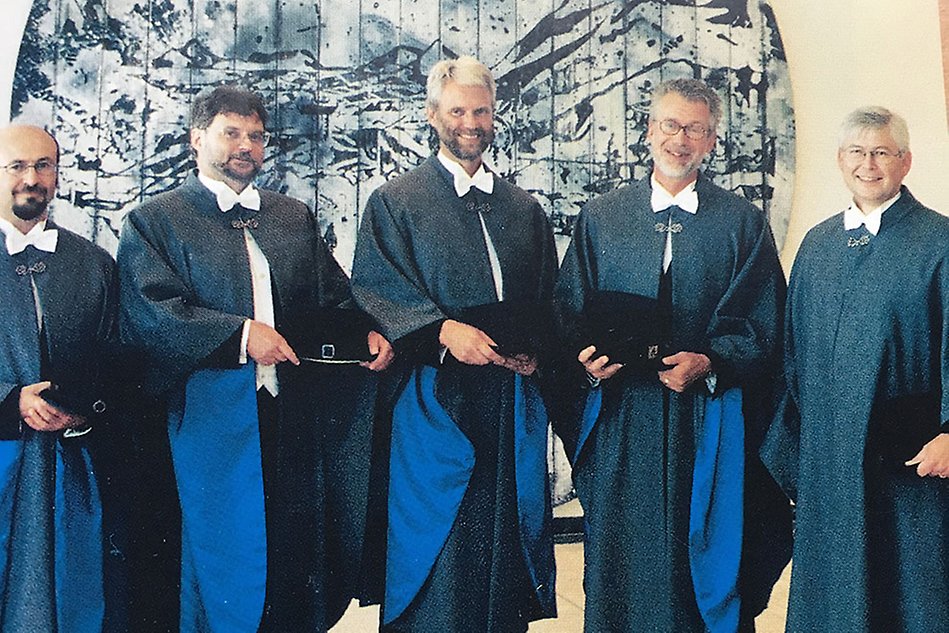
1999: The University's first five Professors are inaugurated.
1998
Lars Fredén is appointed Vice-Chancellor. Josef Bigün is appointed the University's first Professor. The new University Library is opened and the University starts using the glass aisle.
1997
The University is granted permission to establish a number of professorships. Teacher education starts. Centre for computer architecture, CCA, is remade into Centre for data science, CDV.
1996
The University and the Centre for occupational development, CAU, receives the Government's equality prize for significant efforts to promote equality within universities.
1995
The College of Nursing is integrated into the University and Centre for research about health development starts. HHUAB, the University's development company, is started.
1994
The University receives the right to award Master's degrees within several areas. The incubator Innovationsgruppen starts.
1993
IDE-rum (T building) with four work shops used for teaching and making prototypes as well as the lecture hall building Visionen is opened. The University's experiment house is being built.
1992
The European Business Programme starts and gains national attention. Halmstad's new skyscraper Trade Center is opened and becomes a symbol for the young, modern university.
1991
The technology park Teknocenter is formed.
1990
The University becomes coordinator for the EU network WITEC (Women in Technology), part of the EU programme Comett, which aims to increase the number of women in the areas of technology and natural science.
1989
Education for mechanical engineers starts. The University aims high with internationalisation and what is referred to as science outreach. That is, on top of conducting education and research, universities work to promote public awareness and understanding of science.
1988
The University moves to Larsfrid in the eastern part of Halmstad. E and F buildings are opened. Centre for occupational development, CAU starts.
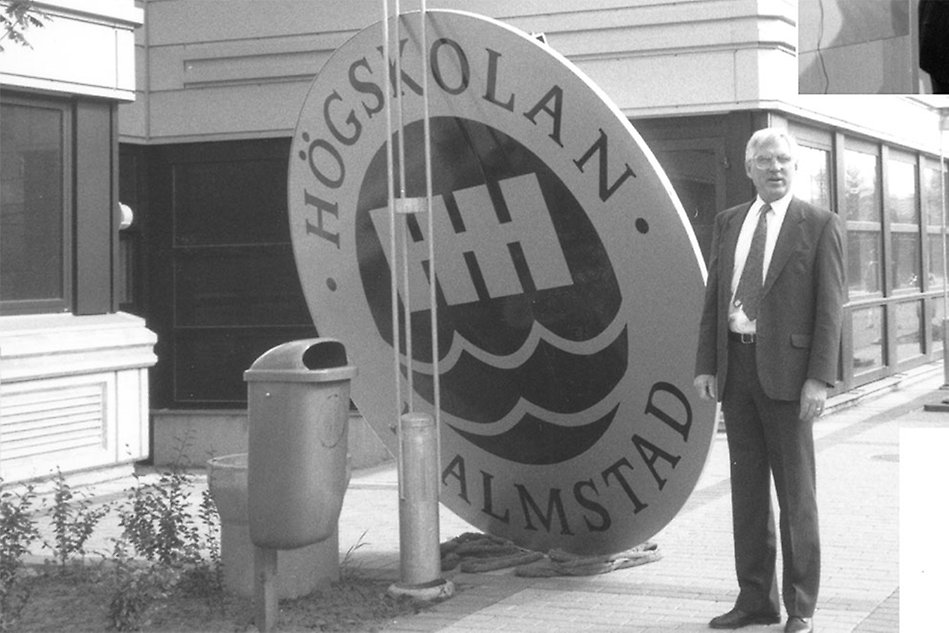
1987
Education Economy with ADB specialisation starts. Pre-School teacher education expands to 90 spots.
1986
The University has severe problems with space. Centres for reserach are started, first up is the Centre for image processing and data analysis, CBD.
1985
The education for innovation engineers becomes three years. Tylösand's research centre and techonolgy park starts.
1984
Education in sports pedagogy starts. The University has a total of 64 employees: 42 teachers and 20 technical/administrative staff
1983
Halmstad University is formally inaugurated as an independent University and has 540 students. Sven-Ove Johansson is appointed Vice-Chancellor.
1982
The institution is established in the western part of Halmstad. Education in Business Administration starts.
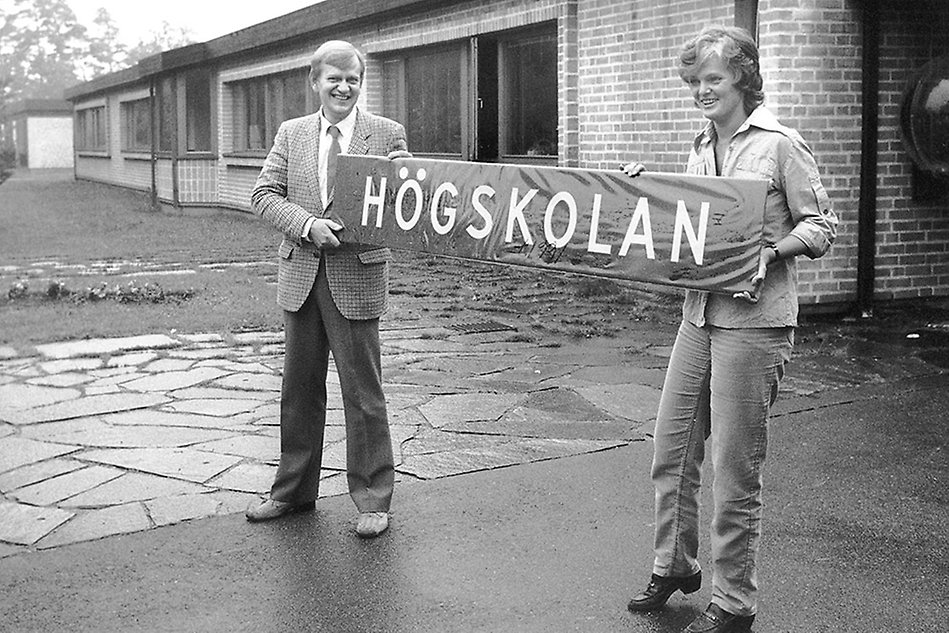
1982: Jan Arvidsson and Agneta Hansson outside Eketångaskolan to where the University moves.
1979
Degree programmes and courses for pre-school teachers and innovation engineers start.
1978
Education for after school teachers starts and the institution begins to offer individual courses in sports education. This is the start of sports pedagogy.
1977
This year marks the beginning of higher education. Jan Arvidsson is in charge.
1976
The County Committee for post-secondary education in Halland is formed.
1975
Halmstad is appointed by the Swedish Parliament as the site of a higher education institution.
1973
Pre-school teacher education is established as a pilot project.
1970
The N-committee is set up to pave the way for a university in Halmstad.

